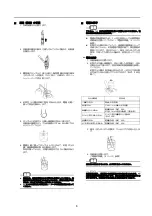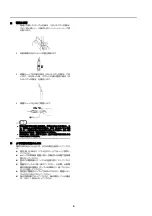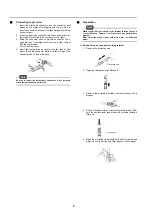
3
Measurement (calibration)
1. Open the internal solution filler port.
2. If necessary, fill the electrode with new internal solution
until the solution level gets close to the internal solution
filler port.
3. Wash the electrode with pure water (or deionized water)
and wipe it with filter paper or tissue paper, prior to every
immersion into the standard or sample solution.
4. When there are air bubbles inside the responsive glass
membrane, stir the electrode lightly to remove bubbles.
5. Immerse the responsive glass membrane and liquid
junction in the sample solution completely.
Make sure that the surface of the internal solution inside
the electrode is higher than the surface of the sample
solution.
6. Rinse the electrode with the sample solution lightly to
remove bubbles. If bubbles remain on the electrode
surface, accurate measurement cannot be performed.
Note
Be sure to keep the internal solution filler port open during
measurement. If it is clogged with the solution, accurate
measurement cannot be performed. Wipe the solution with
cloth.
For calibration and measurement on pH meter, refer to the
instruction manual of pH meter.
Maintenance
Note
Do not use organic solvents (such as acetone or
tetrahydrofuran) as cleaning solutions. Using such chemicals
may damage the body of the electrode or cause a decline in
performance.
To maintain electrode performance, replace the internal
solution approximately every one months.
(Refer to “ Preparation ” (page 2).)
Dirt on the responsive glass membrane or liquid junction
by the test solution may cause a decline in electrode
response and sensitivity or measurement error. If the
electrode is very dirty and cannot be washed clean
using pure water (or deionized water), perform cleaning.
Cleaning of electrode
1. Open the internal solution filler port.
2. Immerse the responsive glass membrane and liquid
junction in the cleaning solution for approximately one
hour until contamination is removed. The responsive
glass membrane can also be cleaned by wiping it with
cotton gauze containing the cleaning solution.
3. Rinse the electrode with pure water (or deionized water)
completely.
4. Replace the internal solution.
(Refer to “ Preparation ” (page 2).)
Note
Be sure to perform calibration prior to measurement after
cleaning the electrode.
Tip
Applying pressure on the internal solution until it exudes from
the liquid junction is effective in stabilizing the pH response.
Excessive pressurization will damage the electrode. Stop
applying pressure on the internal solution as soon as it begins
to exude.
Type of dirt
Cleaning solution
General
Diluted neutral cleaning solution
Oil
Alcohol, or diluted neutral cleaning solution
Inorganic substance
Electrode cleaning solution (model 220) or
hydrochloric acid approximately 1 mol/L
Protein
Cleaning solution including protein-removing
enzyme (model 250)
Liquid junction
Electrode cleaning solution (model 220)
Altered of glass,
Slow-response
Electrode cleaning solution (model 220)


























